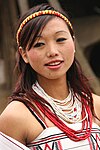Tai Phake people
The Tai Phake people were believed to have migrated from the Shan kingdom of Mongmao, Myanmar in the 18th century.
When the British invaded Assam, they and others of the Shan race were ordered by the Burmese authorities to return to Mogoung.
A significant population of Tai Phake people is found in both Assam and Arunachal Pradesh.
Some of the villages are namely: Namphake, Tipamphake, Borphake, Manmau, Namsai, Manlong, Nanglai, Ninggum, Phaneng, Lalung, etc.
The Tai Phakes possess a written code called "thamchat", which is referred to by the village elders while deciding of local nature.
The penalties for breaches of law, the idea of right and wrong, appear to be genuinely indigenous to their culture.
The rules of conduct that the "thamchat" enjoins on its members are mainly based on ethical principles.
They are monogamous although polygamy is not forbidden provided the man has the requisite means to support such a family.
The husband or a wife files a divorce case before the "chow mann" who takes a decision in the meeting of the village elders.
Dress proper includes articles of personal clothing as are used mainly for the purpose of covering.
There are two dresses for Tai Phakes: A very small amount of ornaments are used as assign of femininity than for enhancing the effectiveness of the personal appearance of the wearer.
For their warm clothes, people depend upon the market products like the coat, sweater, Scarf, Shawl etc.
The dress of the elderly male is generally house woven checkered lungi (Phaa) of green and black color lined with red, yellow or white yarn, undershirt, one shirt (Sho) and a white turban (Fa Ho).
For their warm clothes, the elderly male persons prefer shawls (Fa Jang).
If a girl has an unmarried elder sister, she does not wear a Fa Nangwait even though she has attained puberty.
The dress of unmarried grownup girls constitutes a Chin, a Fa Fek Mai and a blouse.
The boys wear trousers and shirts when they go to Naharkatia or to their schools, while in the village they use their traditional lungi.
It was reported that previously when the marketing centers were not easily accessible, the people prepared all their dyes indigenously.
It was reported that till 1950 the elderly women used Kenhu (an ear ornament made of transparent crystal material) but since that year the supply of that material became irregular and the Phake women had to opt for modern ornaments like earring, bracelets, gold ring, necklaces etc.
Objects of natural beauty like flowers are special favorites of the teenage girls who wear those in their hair.
They also cleanse Buddha images and statues from household shrines as well as from monasteries by gently pouring water over them.
In each month during the day of "purnima" the people of the village gather together in the monastery and offer prayers.
Poi Mai-ko-chum-fai is a festival which is celebrated during the full moon day of February month.
Small piles of wood and hay are set on fire by the people at late evening of this day.
Their meals consist of cooked or steamed rice wrapped in banana or tara or kau leaves that known as "khau how" and boiled vegetables.
Entertainment of the villagers with a feast and gift to the monks are the salient features of their purification ceremony.
After about one year a big festival is arranged and all the Tai Phakes of different villages are invited and the dead body of the monk is ceremonially cremated.


Naga woman